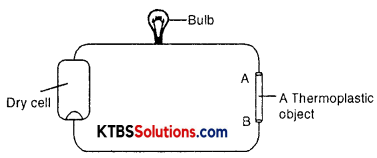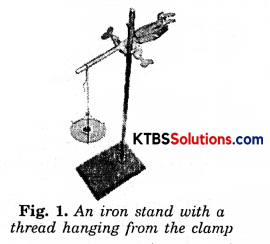You can Download KSEEB Solutions for Class 8 Science Chapter 3 Synthetic Fibres and Plastics Questions and Answers Pdf, Notes help you to revise the complete syllabus.
KSEEB Solutions for Class 8 Science Chapter 3 Synthetic Fibres and Plastics
Synthetic Fibres and Plastics Textbook Questions and Answers
Question 1.
Why are some fibers called synthetic?
Answer:
Some fibers are called synthetic because they are made by human beings, e.g., polyester, acrylic etc.
Question 2.
Mark (✓) the correct answer:
Rayon is different from synthetic fibers because:
(i) It has a silk-like appearance.
(ii) It is obtained from wood pulp.
(iii) Its fibres can also be woven like those of natural fibres.
Answer:
(ii) It is obtained from wood pulp.
![]()
Question 3.
Fill in the blanks with appropriate words:
- Synthetic fibres are also called _______ or _______ fibres.
- Synthetic fibres are synthesised from raw material called _______
- Like synthetic fibres, plastic is also a _______
Answer:
- artificial or man-made
- petrochemicals
- polymer.
Question 4.
Give examples which indicate that nylon fibers are very strong.
Answer:
Parachutes and ropes for rock climbing.
Question 5.
Explain why plastic containers are favoured for storing food?
Answer:
The three main advantages of using plastic containers for storing food are:
- Plastic is nonreactive.
- Plastic is light, strong, and durable.
- Plastic is cheap.
![]()
Question 6.
Explain the difference between thermoplastic and thermosetting plastics.
Answer:
The difference between thermoplastic and thermosetting plastics is:
| Thermoplastic | Thermosetting plastic |
| Thermoplastics soften on heating and then can be moulded into various shapes. They can be melted and shaped any number of times, e.g. polythene, PVC. | Thermosets are plastics which once set, do not soften on heating. They retain the shape in which they were originally moulded. They are harder and stiffer than thermoplastics, e.g. bakelite, melamine. |
Question 7.
Explain why the following are made of thermosetting plastics.
- Saucepan handles.
- Electric plugs/switches/plugboards.
Answer:
- Saucepan handles are made of thermosetting plastics (bakelite) because it is a poor conductor of heat.
- Electric plugs/switches/plug boards are made of thermosetting plastics (bakelite) because it is a poor conductor of electricity.
Question 8.
Categorize the materials of the following products into ‘can be recycled and ‘cannot be recycled’:
Telephone instruments, toys, cooker handles, carry bags, ballpoint pens, plastic bowls, electric wire covering, plastic chairs, electrical switches.
Answer:
- Can be recycled: Telephone instruments, plastic toys, ballpoint pens, plastic bowls.
(As these are thermoplastics, so these can be recycled). - Cannot be recycled: Cooker handles, carry bags, plastic covering on an electric wire, plastic chairs, etc.
(As these are thermosetting plastics, these cannot be recycled).
Question 9.
Rana wants to buy shirts for summer. Should he buy cotton shirts or shirts made from synthetic material? Advise Rana, giving your reason.
Answer:
We would advise Rana to buy cotton shirts because cotton clothes absorb sweat in summers whereas synthetic fibers do not absorb sweat and stick to the body making one feel uncomfortable.
![]()
Question 10.
Give examples to show that plastics are non-corrosive in nature.
Answer:
Examples to show that plastics are non-corrosive in nature:
- A wide range of chemicals is stored in plastic containers.
- Food items are stored in plastic containers.
- (Different buckets and mugs are made of plastics.
Question 11.
Should the handle and bristles of a toothbrush be made of the same material? Explain your answer.
Answer:
No, the handle and bristles of a toothbrush should not be made of the same materials because the handle of the toothbrush must be hard and thus is made of thermosetting plastic whereas bristles of a toothbrush are made up of nylon which is soft, flexible, and strong.
Question 12.
“Avoid plastics as far as possible.” Comment on this advice.
Answer:
Plastic takes several years to decompose. It is not environment friendly. It causes environmental pollution. Besides, the burning process in the synthetic material is quite slow and it does not get completely burnt easily. In the process, it releases lots of poisonous fumes into the atmosphere causing air pollution. Therefore, avoid the use of plastics as far as possible. The plastics garbage should be recycled.
Question 13.
Match the terms of column A correctly with the phrases given in column B.
| Column A | Column B |
| (i) Polyester | (a) Prepared by using wood pulp |
| (ii) Teflon | (b) Used for making parachutes and stockings. |
| (iii) Rayon | (c) Used to make non-stick cookware. |
| (iv) Nylon | (d) Fabrics do not wrinkle easily. |
Answer:
| Column A | Column B |
| (i) Polyester | (d) Fabrics do not wrinkle easily. |
| (ii) Teflon | (c) Used for making non-stick cookware. |
| (iii) Rayon | (a) Prepared by using wood pulp. |
| (iv) Nylon | (b) Used for making parachutes and stockings. |
Question 14.
“Manufacturing synthetic fibers is actually helping conservation of forests”. Comment.
Answer:
Synthetic fibers are obtained by chemical processing of petrochemicals and not from fibres obtained from plant and animal sources. Hence we do not have to cut trees for manufacturing synthetic fibres and thus forests are conserved.
![]()
Question 15.
Describe an activity to show that thermoplastic is a poor conductor of electricity.
Answer:
Take a dry cell to connect conducting wires and electric bulb with it, keeping a gap of 5 cm between two ends (A and B) of conducting wares in the circuit. Place an object of thermoplastic in the gap making sure that it touches the ends of the wires and thus the circuit is completed.

The bulb does not light up. However, if the thermoplastic object is removed from the circuit and ends A and B are joined then the bulb glows up. This shows that thermoplastic is a poor conductor of electricity.
Synthetic Fibres and Plastics Additional Questions and Answers
Question 1.
How are fabrics made?
Answer:
Fabrics are made using fibres obtained from natural or artificial sources.
Question 2.
Name few natural fibers.
Answer:
Jute, cotton, silk, and wool.
Question 3.
Name few artificial fibers.
Answer:
Rayon, terylene, nylon, polythene, Teflon, etc.
Question 4.
What is a polymer?
Answer:
Polymer (poly means many, mers means parts) is a large molecule comprised of repeating structural units (monomers) joined together. There may be hundreds or even thousands of structural units in a polymer.
![]()
Question 5.
What is rayon?
Answer:
The artificial silk prepared from cellulose is called rayon.
Question 6.
Write the uses of rayon?
Answer:
The uses of rayon are:
- Rayon mixed with cotton is used for making nurses’ dresses. Rayon makes them easier to wash and more hygienic.
- Rayon mixed with wool is used for making carpets. Rayon makes them lighter and more durable.
- Rayon gauze is used in bandaging. Rayon gauze can absorb over 90% of its own weight of water. Rayon gauze does not adhere to wounds.
Question 7.
How is nylon prepared?
Answer:
Nylon is prepared from coal, water, and air.
Question 8.
Write the properties of nylon.
Answer:
The properties of nylon are:
- It is strong, elastic, and light.
- It is lustrous and easy to wash.
Question 9.
Why is polyester suitable for making dress material?
Answer:
Polyester is suitable for making dress material because this fabric does not get wrinkled easily. It remains crisp and easy to wash.
![]()
Question 10.
What is PET? What are its uses?
Answer:
PET is a very familiar form of polyester. PET is used for making bottles, utensils, films, wires, and many other useful products.
Question 11.
Why we should never wear polyester clothes while working in the kitchen or in a laboratory?
Answer:
We should never wear polyester clothes while working in the kitchen or in a laboratory because in case of fire the polyester fabric melts and sticks to the body of the person wearing it.
Question 12.
How are all synthetic fibres prepared?
Answer:
All synthetic fibres are prepared by a number of processes using raw materials of petroleum origin called petrochemicals.
Question 13.
Write unique characteristics of synthetic fibers} which make them popular dress materials.
Answer:
The unique characteristics of synthetics fibers are:
- They dry up soon
- Are durable
- Less expensive
- Readily available
- Easy to maintain
![]()
Question 14.
What are plastics?
Answer:
Plastics are polymers of very high molecular masses. They are generally not affected by acids or alkalis. They can be moulded to any desired shape.
Question 15.
Why storing any food item, water, milk, pickles, dry food, etc. Plastic containers seem most convenient?
Answer:
Storing any food item, water, milk, pickles, dry food, etc. plastic containers seem most convenient because of their lightweight, lower price, good strength, and easy handling.
Question 16.
Which property of plastic makes it useful in cars, aircraft, and spacecraft?
Answer:
Plastics are lighter compared to metals, therefore, they are useful in cars, aircraft, and spacecraft.
Question 17.
Which material is called biodegradable?
Answer:
A material which gets decomposed through natural processes, such as action by bacteria, is called biodegradable.
Question 18.
Which material is called non-biodegradable?
Answer:
A material which is not easily decomposed by natural processes is termed non-biodegradable.
![]()
Question 19.
The disposal of plastic is a major problem. Why?
Answer:
Disposal of plastic is a major problem because:
- It takes several years to decompose.
- If burnt that it takes a long time to get completely burnt and in the process, it releases a lot of poisonous fumes into the atmosphere causing air pollution.
Activities
Activity 1
Make a list of some common articles made from fibers. Try to separate them into those made from natural fibers and those made from artificial fibers. Make entries in Table (a).
Table (a): Natural and Artificial Fibres
| Name of Article | Type of Fibre (Natural/artificial) |
| 1. Acrylic sweater | Artificial |
| 2. Woollen sweater | Natural |
| 3. Cotton shirt | Natural |
| 4. Nylon saree | Artificial |
| 5. Nylon tents | Artificial |
Question (i).
Why did you label some fibers as artificial?
Answer:
We have labelled some fibres as artificial because they are man-made fabrics.
Activity 2
Take an iron stand with a clamp. Take a cotton thread of about 60 cm in length. Tie it to the clamp so that it hangs freely from it as shown in Fig. 1. At the free end suspend a pan so that weight can be placed in it. Add weight one by one till the thread breaks. Note down the total weight required to break the thread. This weight indicates the strength of the fiber. Repeat the same activity with threads of wool, polyester, silk, and nylon. Tabulate the data as shown in Table. Arrange the threads in order of their increasing strength.

Observation Table
| Type of Thread/Fibre | Total weight required to break the Thread |
| 1. Cotton | |
| 2. Wool | |
| 3. Silk | |
| 4. Nylon |
Activity 3
Take two cloth pieces of the same size, roughly half a meter square each. One of these should be from natural fiber. The other could be synthetic fiber. You can take the help of your parents in selecting these pieces. Soak the pieces in different mugs each containing the same amount of water. Take the pieces out of the containers after five minutes and spread them in the sun for a few minutes. Compare the volume of the water remaining in each container.
Question (i).
Do synthetic fabrics soak less/more water than natural fabrics?
Answer:
They soak less water.
![]()
Question (ii).
Do they take less or more time to dry?
Answer:
They take less time to dry.
Question (iii).
What does this activity tell you about the characteristics of synthetic fabrics?
Answer:
Synthetic fabrics soak less water and take less time to dry.